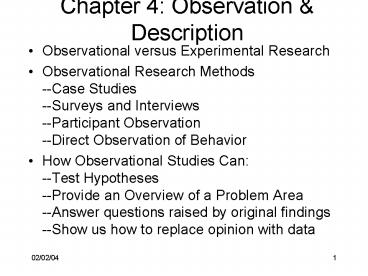Chapter 4: Observation - PowerPoint PPT Presentation
1 / 33
Title:
Chapter 4: Observation
Description:
Provide an Overview of a Problem Area --Answer questions raised by ... Miller (1984) interviewed Hindus in India vs Americans in the USA. Results. Confounds? ... – PowerPoint PPT presentation
Number of Views:48
Avg rating:3.0/5.0
Title: Chapter 4: Observation
1
Chapter 4 Observation Description
- Observational versus Experimental Research
- Observational Research Methods--Case
Studies--Surveys and Interviews--Participant
Observation--Direct Observation of Behavior - How Observational Studies Can--Test
Hypotheses--Provide an Overview of a Problem
Area--Answer questions raised by original
findings--Show us how to replace opinion with
data
2
Two Classes of Research
- Experimental Research
- Researcher intervenes to make something happen
- Manipulation of an independent variable
- Other influences (variables) held constant
- Non-Experimental or Observational Research
- Researcher does not deliberately make s.t. happen
- Observes/describes carefully
- Observes/measures how one variable varies as a
second variable varies
3
Case Studies
- Study one or a few cases in depth
- Rationale Rarity of occurrence
- Examples brain damage, rare diseases or
condition
4
Neuropsychology Example Brocas Aphasia
5
Brocas Speech Area
- Patient Tan suffered from Expressive Aphasia
- Damage to specific area (Brocas Area)
- Localization of function
- Specific case bearing on general issue
- Follow-ups
6
Strengths of Case Studies
- Useful in telling us what can happen (e.g. damage
to a specific area of brain leads to a specific
deficit) - Useful in suggesting new lines of research or
ideas
7
Limitations of Case Studies
- Generalization Issue
- Tell us something can happen but not whether it
typically happens - Susceptibility to two sources of
error--Observer bias (e.g. see what you wish to
see)--Observer Effects (e.g. ask for elaboration
of some statements not others)
8
Construction of survey questions an Art in Itself
9
Surveys Interviews and Questionnaires
- What is true of large groups of cases?
- Proper sampling critical
- Representative sample critical
- Specialized Technique
10
Surveys Problems
- Sampling cases can be very tricky
- Writing survey questions quite difficult--speciali
zed topic - Hence no surveys for projects
11
Demographic Study Cohabitation Divorce
- 1940s - 1960s Cohabitation rate increased
- Is it good for couples to live together before
marriage? - Two perspectives
12
First Perspective
- Trial marriage (i.e. living together) may prevent
many unsuitable marriages - Astin, Korn, Riggs 1993 survey of 300,00
college students - 51 agreed a couple should live together before
marriage
13
Second Perspective
- Cohabiters more likely to regard marriage as an
experiment than a commitment -gt more likely to
divorce if dissatisfied - Investigate (look and see) -gt Surveys (Greeley,
1991 Bennet, Blanc, Bloom, 1988) - Finding Couples who cohabitated before marriage
more likely to divorce (by a factor of 2 to 1)
14
Causality Issue
- Does cohabitation cause a higher level of
divorce? - Not necessarily
- Perhaps cohabitation AND divorce both reflect a
common factor - What can we say?
15
An Social Psychology ExampleBennington College
16
Bennington College in 1933
17
Bennington Studies
- Attitudes and attitude change
- What is the effect of contact with a society on
attitude change? - How were attitudes operationalized?
- Changes?
- Long-term effects
18
Follow ups
- 25 years later
- Problems?
- Appropriate comparison group
- 1st group
- 2nd group
- Concerns? Confounds?
19
Cultural Psychology Explanations of Action
- Explaining peoples actions
- Personality Traits vs Situational Factors
- Miller (1984) interviewed Hindus in India vs
Americans in the USA - Results
- Confounds?
20
Participant Observation
- Study behavior of group from the inside
- Scientists participate in groups activities
- Example from Social Psychology The Seekers
- Cognitive Dissonance Theory
21
The Seekers
22
Direct Observation of Behavior
- Observe behavior directly from outside
situation--watching in a systematic way - Naturalistic observation
- Ethology Sex and the Stickleback
- Human Ethology 1 Facial Expressions
- Human Ethology 2 Book Carrying
23
An Example from Ethology Sex and the Stickleback
24
Sex and the Stickleback
- Classic ethology study of complex reproductive
behavior - Males behavior threat display vs. zigzag
dance - What triggers these responses?
- Learned or innate behavior?
25
Human Ethology I Facial Expressions
26
Facial Expressions
27
Laughter
28
Human Ethology II Book Carrying
29
Testing Hypotheses with Observations
- Example from Clinical Psychology Smoking,
Obesity, and Self-Help - Example from Social Development Maternal
Responsiveness and Infant Crying
30
Example from Social Development Maternal
Responsiveness and Infant Crying
- Whats a Parent to do?
- Reinforcement Theory versus Attachment Theory
- Predictions (Figures)
- Bell Ainsworth (1972)
31
Predicted Results
32
Value of Observational Research
- Theory/Data Cycle -- Data to theory
- Exploratory or Open-ended Questions
- Testing Hypotheses
- Correlation does not imply causality
- But correlational studies can sometimes
disconfirm predictions of causal theory
33
Summary































